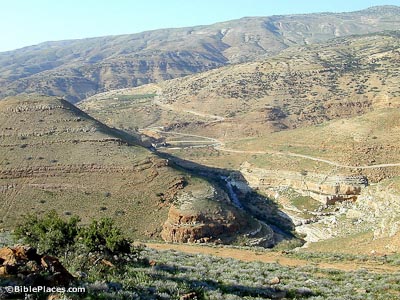 |
| Fords of the Jabbok, the supposed location of Mahanaim and Peniel/Penuel. From bibleplaces.com |
Genesis 32
Genesis
32: 3, NIV Jacob sent messengers ahead of
him to Seir, the country of Edom.
It seems
as if Esau has moved to a new home in the time that Jacob has been gone. Seir
refers to the mountain range that covered most of Edom. In the biblical record,
Esau’s descendants settle on this land after displacing the Horites.
Archaeological references have the earliest settlements appearing in the Iron
Age, and date to the 9th century BCE, and that Edom did not become a
complex society and kingdom until the 8th century BCE.
We find
Jacob praying to God in this chapter, after he hears that Esau is coming to
meet him with 400 men. We don’t see Jacob praying in many other instances, and
now he is praying for selfish reasons; he believes Esau is coming to kill him.
Jacob wants God to save him from his brother, the same brother he deceived,
tricked, and cheated multiple times.
Jacob
fights with an angel of God, and wins. It is interesting when you compare this
interaction with Abraham and Lot, who immediately fall down on their faces when
in the presence of an angel.
After
this wrestling match, God renames Jacob Israel, which means “he struggles with
God”. Oddly, skimming ahead, he is still called Jacob in later chapters of the
Bible, unlike his grandfather Abraham after his name change.
Commandment 3/613 Laws in the Torah (Gen. 32:33) Not to eat the sinew of the thigh. Therefore to this day the Israelites do not eat the tendon attached to the socket of the hip, because the socket of Jacob’s hip was touched near the tendon [by God].
New words:
Mahanaim
– (“This is the camp of God!” So he named
that place Mahanaim.) Mahanaim is mentioned 13 times in the Old Testament
(but no where else), and means “two camps”. It is believed to lie about ten
miles east of the Jordan River. In this area there are two large tells that
face each other with the Jabbok river flowing between them. The tells are now
named Tall adh-Dhahab East and Tall adh-Dhahab West. Some biblical scholars
believe them to be Mahanaim and Penuel. While this has never been proven, there
is an archaeological site at Tall adh-Dhahab West, since 2006, when building
remains from the Hellenistic and Roman era were found, believed to be part of a
monumental building of Herod the Great (73-4 BCE).
No comments:
Post a Comment